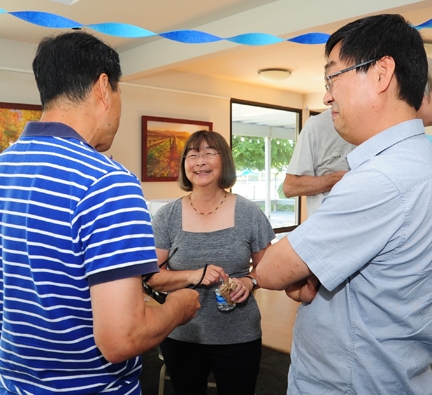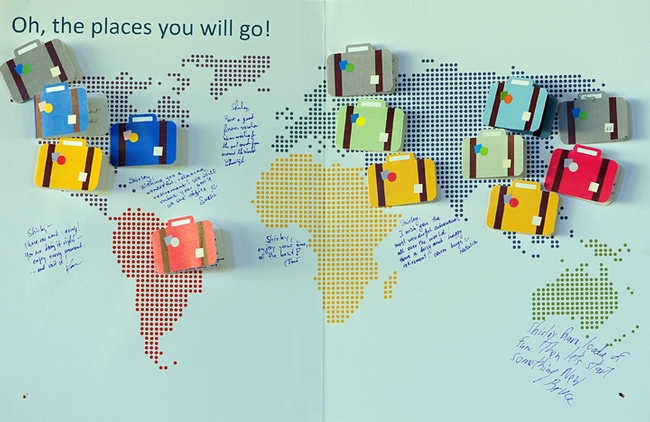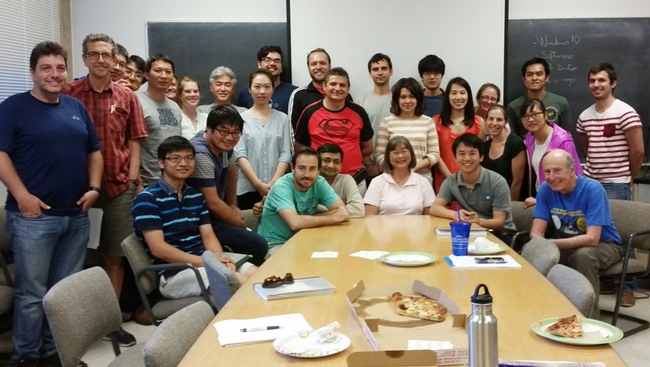- Author: Kathy Keatley Garvey

DAVIS--If you preface her name with “research scientist” or “renowned toxicologist,” followed by “40 years of service at the University of California, Davis,” those words don't even begin to describe her or her work.
Shirley Gee, principal investigator, lecturer, mentor and the longtime manager of the Bruce Hammock research lab, UC Davis Department of Entomology and Nematology, retired June 30, leaving a long chain of accomplishments, admiration, appreciation and affection extending locally, nationally and globally.
Gee, who joined the Hammock lab in 1985, managed a team of researchers that annually included some 40 scientists: graduate students, technicians, post graduates and visiting professors from all over the world.
“Forty seems like a crazy big number,” Gee said, “and I am a little overwhelmed by it (the number).”
"Shirley Gee is a Davis hero," said Hammock, distinguished professor of entomology who holds a joint appointment with the UC Davis Comprehensive Cancer Center. "Her resume of 147 peer review publications is the envy of most faculty members, but Shirley's personal research was just a part-time job. She provided the infrastructure for an interdisciplinary laboratory averaging 40 people for decades; she was key to the infrastructure of the department ranging from installing and maintaining computers through chemical safety and control.”
“She has been a parent, colleague and friend to scores of visiting scientists and students from around the world,” Hammock said. “Shirley is a gifted teacher both in the classroom situation at UC Davis but also in outreach where she has provided training to governmental and industrial scientists from around the world. She was the principal investigator of multiple projects bringing a large amount of research funding to the campus. Internationally she best known as the face of the discipline of environmental immunoassay having edited two books in the area and working on a third volume now. Her impact in the field was demonstrated last December when she organized a symposium held in Hawaii on environmental biosensors, attended by scientists from around the world. In fact scientists, from five countries attended a surprise dinner for Shirley at the University of Hawaii."

In 2011, Gee received the UC Davis Staff Assembly's Citation for Excellence, presented by the chancellor. “Shirley seeks ways to help the lab and the department be successful,” the nominators wrote. “She is extremely efficient and effective” and a “can-do person skilled at anticipating and solving problems in a friendly, courteous and timely manner.”
Her fellow employees praised her competency and friendliness. “Her input is critical to every project underway in our lab,” Hammock related. “One research project brought almost $2 million in direct costs to the campus last year; she is one of the unsung heroes who keeps this program going.”
A UC Davis alumnus and a longtime member of the Society of Toxicology and American Chemical Society, Gee holds a bachelor of science in biological sciences and a master's in pharmacology and toxicology (1981).

At UC Davis, Gee quickly advanced in her career: from laboratory helper in the Department of Biochemistry and Biophysics to lab assistant, staff research associate IV and adjunct lecturer in the Department of Environmental Toxicology, to toxicologist at SRI International in Menlo Park, where she worked three years before joining the Hammock lab. Since 2007, she has served as the director of research and founding member/manager of Synthia LLC, Davis.
“I have long been interested in human and environmental exposure to toxicants and utilizing screening methods to evaluate the presence of the toxicant as well as the potential for effects,” Gee writes in her biosketch. “Immunoassays have been used clinically for more than 50 years to detect the presence of drugs, hormones and microorganisms for human medical diagnostics.”
Long-term colleague Bruce Hammock is a pioneer in the field that applies immunoassay and biosensor technology to environmental toxicants. “Shirley led a project that extended the technology to measurement of a variety of environmental toxicants including pesticides, industrial byproducts, bioterror agents and flame retardants,” Hammock said. It also included the application of new concepts to improve the robustness, sensitivity and high throughput that is required for environmental analysis and for the analysis of low level exposure to toxicants in humans and animals in large scale studies.
Gee has collaborated with investigators from the U.S. Environmental Protection Agency, Uruguay, Mexico and Sweden using the assays for dioxins. She participated in a farmworker exposure study on the herbicide paraquat in Costa Rica and a farmer/consumer study in Thailand on exposure to pyrethroid insecticides. She is also noted for exploring novel immunoassay technologies, such as the use of nanobodies and to transfer this technology to end users throughout the world.

Her major contributions to science are four-fold:
1. Her dissertation work focused on the comparative metabolism of xenobiotics in vivo and in vitro. She worked with a variety of organisms including rats, mice, monkeys, insects and marine invertebrates. This provided a foundation for later work on the development of novel primary hepatocyte cell cultures as high throughput screening methods to assess xenobiotic toxicity and to explore mechanism of toxicity. Her colorimetric assay for monitoring cytochrome P450 assays are the basis of assays used now to monitor these enzymes in projects ranging from drug metabolism to environmental health.
2. Working with Hammock who pioneered the development of immunoassays for pesticides, Gee developed the first immunoassays for pesticides found as ground and surface waters contaminants by the California Department of Pesticide Regulation. Some of these assays were transferred to their analytical laboratory where in the early 1980s they helped end fish kills and drinking water contamination from rice herbicides. Shortly thereafter she co-authored a user's manual on assay development and use as a cooperative project with the U.S Environmental Protection Agency (EPA). The basic assay development and validation continues today and has found application to many environmental contaminants and includes the development of commercially available test kits.
3. Her interest in metabolism led her back to extending assay development from parent compounds to their metabolites. “Metabolites excreted in urine are useful biomarkers of exposure and the immunoassays developed have been used in several exposure studies,” Gee explained. “The studies have provided guidance to help reduce pesticide exposure by examining pesticide exposure patterns based on urine tests, then relaying educational information to the population.”
4. Since 1975 the gold standard of antibody reagents has been monoclonal antibodies. Touted as a better defined and continuously available reagent for immunoassays, monoclonal antibodies have applicationsboth in analytical chemistry, including such things as home pregnancy kits and therapeutics where many new drugs are monoclonal antibodies. However, they are limited because their size does not allow penetration of the cell membrane and ‘humanizing' them for therapeutics is difficult. At 1/10th the size, single domain antibodies derived from camelids (VHH) will penetrate cell membranes, are easy to clone, express and genetically modify. Leading a team of researchers Gee explored the utility of these novel antibodies for the detection environmental contaminants and other small molecules. "Where else but Davis could we have had llama and alpaca around the corner?" Hammock quipped.
Gee was honored at a surprise ceremony at the 2015 International Chemical Congress of Pacific Basin Societies (Pacificchem), held Dec. 15-20 in Honolulu. The group meets every five years. Gee conducted a symposium at the event, which included scientists from seven countries that she has trained.
The surprise party originated with Quing Li, professor at the University of Hawaii and a Hammock lab alumnus, and Hammock. The group presented her with a professional grade ukulele as a retirement gift.
Well-wishers gathered July 22 in the Stonegate Country Club, Davis, for another retirement party.
Gee, who grew up in Elk Grove, recalled some of the highlights of her career.
“I am really a hometown girl,” she said. “I grew up in Elk Grove and got my bachelor's degree in biology at UC Davis. I had taken some elective courses in environmental toxicology. Not having any idea about what happens next, except that I had to find a job, I started knocking on the doors of my professors, including one from E. Tox. He hired me as a lab helper on a trial basis and my career built from there. Eventually, he encouraged me to obtain an advanced degree. So I decided to get a master's degree in pharmacology and toxicology. It took a lot of years because I was in no hurry, was only going to school part time and the final step was a dissertation and publication of my research. I don't much like writing, so that took time. The driving force was that my boss Dr. Robert Krieger, moved to another university. At the time Dr. Krieger introduced me to Bruce Hammock, because he knew Bruce was coming to Davis. But Bruce couldn't hire me, because his funding was tied up in the research office. So instead I went to work in the comparative metabolism lab at SRI International working with some former grad school alumni. About three years later when I decided to return to Davis, I approached Bruce and lo and behold, the timing was perfect. His staff research associate (SRA) was just leaving. “

“Research accomplishments are hard for me to describe because the vast majority of work that I have published is accomplished by very talented and driven researchers in the lab,” she said. “My staff role provides support so that the infrastructure of the lab runs smoothly allowing the researchers to do their work efficiently. My mentor role provides guidance and probably what I love the most is tossing around ideas just to see what might stick.”
What will she miss about UC Davis and the Hammock lab?
“I won't miss much about UC Davis,” Gee said. “That's because I don't have plans to leave the Davis community and as a member of the retiree community I pretty much will still have access (and at discounted rates) to all the cool things about UC Davis, the library, Mondavi, the Arboretum. As for the Hammock lab, well, of course, it is all the people. Bruce has been a steadfast friend for many years and I will miss our daily interactions. It has been wonderful to share hopes and dreams of the students and postdocs and visitors that have come through the lab.”

“I have nothing specific planned immediately except for some travel. The fantastic thing about working in this lab is that I have made many friends that live all over the world. I will enjoy touching bases with them again in person. As for long term plans? Those that know me, know that I will not sit still for long. There is going to be something out there that tweaks my interest and that I will give it to wholeheartedly.”
"Shirley Gee is one of the truly amazing people that I have known,” Hammock said. “ She looks for things to do, and everything she does is accomplished efficiently and creatively. She is understated but perfect at every goal. Then she accomplishes all this while being encouraging, kind and understanding. Having Shirley as a colleague and particularly as a friend has been one of the most wonderful gifts in my life. We all wish her well."
Said Hammock lab researcher Christophe Morisseau: “To put it simply, we are becoming orphans. Shirley has been the lab's Mom for many years, and took care of numerous time consuming administrative duties as well as directing the ‘immunoassay' part of the lab. Like a Mom, she cannot be replaced.”
Said Hammock lab program manager Cindy McReynolds, shortly before her colleague's retirement: “Shirley is the first person everyone goes to for information and is a constant source of sound advice. I can't tell you how many times she would walk into the office while we were debating a problem and offer the most logical and simple solution. After thinking on it for a second, we would all say, ‘that makes sense, why didn't we think of that hours ago!' She also seems to know when to just listen. I'm going to miss her.”
Longtime Hammock lab administrative assistant Grace Bedoian, now retired, recalled that “Shirley was always composed and got the job done. She was really a pleasure to work with.”
Hammock lab executive administrative assistant Louisa Lo was more optimistic. “Shirley is not retiring,” she declared. “She is only working from home!”






